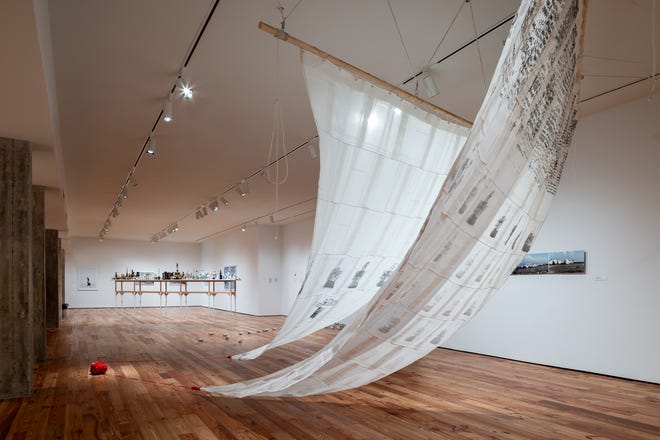“Juana Valdés: Embodied Memories, Ancestral Histories” is an ambitious solo exhibition of the Cuban expatriate’s work at Sarasota Art Museum.
Valdés’ mediums include ceramics, video, photography, video, installation, and printmaking. Her obsessions include colonization, politics, social hierarchy, migration, the indigenous diaspora, Caribbean identity, gender, representation and the notion of race. It’s a complicated body of work, to say the least. Curator Francine Birbragher-Rozencwaig lucidly reveals the artist’s intentions in this show. She keeps it simple – but never oversimplifies.
“A Coat for the Old Man” (“Un saco para el Viejo,” 1993) is the first thing you see. It’s a huge, burlap suit, stitched together by the artist’s mother. It reminds me of David Byrne’s suit in the 1984 film “Stop Making Sense.” But it’s actually a nod to Valdés’ Afro-Caribbean roots. The suit belongs to Babalú Ayé, a deity in the Yoruba religion – the god of healing and renewal. On Dec. 17, thousands of Cubans put on burlap garb and honor him in a street procession. It’s officially Saint Lazarus Day, but they know whom they’re celebrating.
At first glance, Valdés’ “Redbone Colored China Rags” (2012) looks like a line of multicolored rags hanging from the wall. (They’re actually bone china, not cloth.) Moving from left to right, these pieces shift in hue from light pink to dark brown. The key to this color code is race. The lighter the color, the higher the social position. It’s a sharp critique of the spectrum of skin tone and status.
“Terrestrial Bodies” (2020) fills a room with tacky knick-knacks and tchotchkes that Valdés has collected over the years. (Elephants, pagodas, gongs and the like.) The exoticism of “darkest Africa” and “the mysterious East” is the unifying theme. Colonialism shuffled the genetic deck for millions of people – Valdés included. It also shuffled the iconography of appropriated cultures. The result is what you see here: Complex cultural identity has been reduced to insulting cliché.

“On the Boardwalk” (“En el Malecon,” 2000) is a dream of individual and collective escape. This massive photo shows the artist hunkered down below Havana’s chief boardwalk. Valdés is at the water’s edge, and launching a fleet of tiny paper boats — a poignant echo of the flotilla of refugees from Castro’s Cuba. She made them with torn-out pages from Cirilo Villaverde’s “Cecilia Valdés” (1882), a tale of exile and oppression in colonial Cuba. Valdés herself is an exile; she left Cuba for the United State when she was only seven years old. She didn’t set foot on Cuba again, until she returned to create this piece at the dawn of the millennium.
A view from the distance
When you see it across the room, Valdés’ “Farewell to the Sea,” (“Otra vez al mar,” 1994) looks like a pretty, floral print dress of organza fabric, softly illuminated from within, and hanging from the ceiling like an upside-down flower. Get close, and you can see it’s pretty dangerous. She’s anchored it to the floor with a fishnet ringed with sharp fishing hooks. Migration’s bloody casualties are clearly implied.
“The World Upside Down and Flat” (2007-2009) hints of horrors from beyond the horizon. (This piece is actually two installations yoked together.) To create it, Valdés first silk-screened scores of handkerchiefs with prints of Spanish galleons. She then sewed the handkerchiefs together to make two big triangles resembling inverted sails. At the base of this installation, she’s tied the sails to a rock with a bloody red ribbon. (A reference to the conquistadors’ violently stolen gold.) At the top of the sails, there’s an angry storm cloud of text. That’s where she’s repeatedly printed a passage from Joseph’s Conrad’s “Heart of Darkness” …

The offing was barred by a black bank of clouds, and the tranquil waterway leading to the uttermost ends of the earth flowed somber under an overcast sky, seemed to lead into the heart of an immense darkness.”
That heart of darkness was colonialism. It ended with horror in Conrad’s novel – and in the real world as well.
That’s just one of the ancestral insights you’ll find here.
Valdés appears in a few photographs. But her focus isn’t me, myself and I. Her personal narrative bleeds into a larger history. The hellish odyssey of Cubans and Africans across the Atlantic Ocean is just one chapter.

Once upon a time, various Western empires looted the world. They stole treasures. They stole human beings from several continents and put them to work. These exploited peoples wound up scattered around the globe. Cultural memories were forgotten. The answers to two important questions were lost – Who am I? Where do I come from?
Valdés answers those questions with her art. Each piece is a moment of lost time recaptured. This exhibition puts some of her best work together, and lets you see it in one place. Don’t miss it.
It’s a treasure trove of cultural memory.
‘Juana Valdés: Embodied Memories, Ancestral Histories’
Runs through Feb. 11 at Sarasota Art Museum, 1001 South Tamiami Trail, Sarasota; 941-309-4300; sarasotaartmuseum.org